In early summer, after the crest of the first wave of the pandemics had broken and kids resumed to go to school and street cafés had opened again, I spent days alone writing on the balcony of a flat in a somewhat sketchy Berlin neighbourhood. Down in the street, two storeys below, groups of young guys drove their BMWs on extra broad tires in search for a place to park, sending bass heavy music pulsing through the stone valley between the old city blocks. Elderly women chatted underneath, ambulances howled past on the main street, and the occasional drunk yelled out in front of the house.
I was sitting suspended amid the noises and the lifelines they connected to one another. And at the same time I was galaxies away, englobed by the green light of the linden tree which grows in front of the house. The stem rises up directly opposite of the balcony, so that in summer it becomes a tree house sunk into the moist twilight of the canopy. Writing, I only needed to stretch out my hands in order to touch the fresh twigs, the leaves and the fine fur on their surface. And the blossoms. Oh yes, it was the linden blossoms which made my home for these days of writing in the city summer. Tens of thousands of tiny yellow-greenish petals had unfolded and opened the gates of scent, of that sweet honey-scent which has become my instinctive idea of summer in the city. Linden trees are a rare paradox, as they are strong as an oak, and sweet as a rose. Botanically, they belong into the family of the mallows.The tall tree which at the same time is a flower provides a glimpse into the depths of the ongoing creation of the world. We see—we smell—that in these depths tenderness and power, endurance, and fragility are not separated. This understanding is provided by the linden’s scent. I can’t help but understand when I am in the linden’s proximity, although I might never be able to consciously express the full scope of this understanding. I am sucked into it; I am called to partake in it; I am fed by it.
So, I passed the early summer writing, and being part of the tree. I was part of what it breathed out, sweet scent, and provided what it breathed in, carbon dioxide from my lungs, and, ultimately, my flesh. I was part of the bees’ hum, and the bugs’ flicker, and the wind’s dance in the branches, which, when I allowed my gaze to lose itself among the ten thousand gazes of the open blossoms, unveiled itself as a huge body breathing, and breathing myself with it.
Trees and their irresistible ways of expressing their lives and what is important to them are not only providing evidence that the plant kingdom is full of feeling like ours. They are not only supporting the intuition that the world in its inner core is sensible and experiencing: A huge consciousness-in-the-flesh. Trees are the proof that the world’s consciousness is accessible to us. They are the embodiment of us accessing it all the time, of us being in the midst of it, through every breath we take, which in truth is an act of sharing our being with the plants, giving them the substance of our bodies (the CO2 we exhale) and drawing in theirs (the oxygen they provide).
It is the most simple and most mystical process imaginable, because it describes how the total of the world, split up into individuals who yearn for life, meets and becomes whole again through the exchange of bodies, through the exchange of breath – being knotted together in an inseparable something which the cultural ecologist David Abram has referred to as the “Commonwealth of Breath”. The breath we create all together, we breathe out together, which nourishes us because of our togetherness.
Sitting in the dim globe of the linden tree, breathing its breath and realizing that its breath is fragrance, and becoming fragrance myself, I understood that there is no “nature” there, with trees and bugs and snails and water and mountains, and humans here, but that there is only mutual transformation in the desire to exist.
Trees are our mirror neurons by which we can probe into the vast world of this mutuality, which ultimately is the labyrinth of our own body, the root of our own psyche wandering through the soil of the world in the same way the root hairs of the linden tree incessantly move about, in the dark soil beneath the Berlin city street, under the growl of broad tires, sheltered from the sun and the nightly light of the stars, sending water and food up to the innumerable tiny blossoms gazing into space, breathing out the perfume of life.
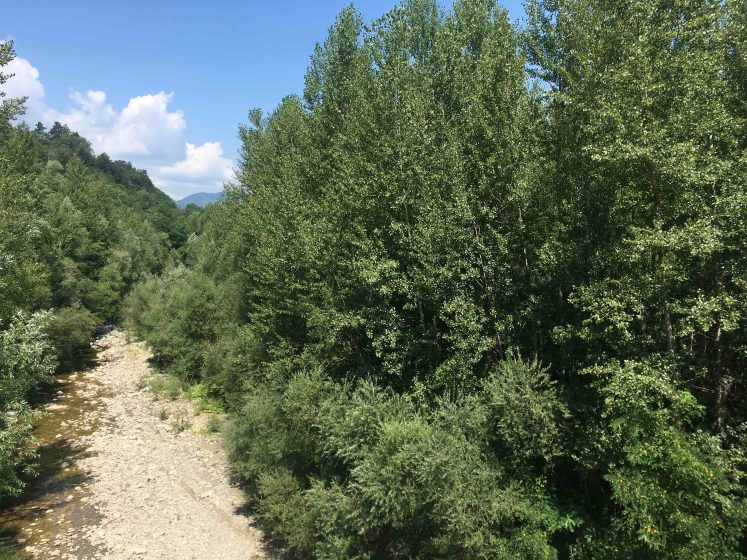
Aspen
When the aspen’s life ends, another one is just beginning. It is a life not of whispering leaves in a southern summer breeze, but rather as massive white bones blocking the course of the mountain stream. When you scramble down into the river valley, you don’t immediately recognize the uprooted trees among the round stones bleached by the sun. The white waters of winter have peeled away the bark and washed the timber clean, so that it shines like a bone, a huge remnant of lived life, white as the sun at noon. The logs are twisted and bent, flashes of negative images of their eager growth along the stony banks of the Appenine stream.
The splintered trees in the river bed echo the wind that once rushed through their twigs and bent their stems. Now they don’t stand anymore. They lie down. The river water splashes over them, after a strong rain has filled the empty gravel bed with restless power. The logs are pulled away by the water, crash into boulders, are pushed on, then become stuck again, heaping up mounds of stones along their white bones. The pebbles rattle and rush, slash and gush. They make the air brim with the echo of fluttering leaves.
Among the stones of the river bed, the aspens answer the sun’s gift of power with their contorted bodies reaching towards the sky. They have become toys of the water. When the waves rip away parts of the dry earth of the shores, the huge trees are pulled down and away. They become the water’s instruments, its willing helpers. As long as they are rooted in the soil, they serve the sun, are a condensed form of its energy and feed it to the other beings. Now the stems have become crystallized water. They trace its forces, become their dancing partners, become crest of the wave and thundering liquid. The wood is reborn as bleached wave and rounded pebble. First it was light, then it becomes liquid, until it finds its last shape as mineral.
The splintered, withered trunks lie still in the hot riverbed, crackling in the sun, half buried by stones. Every aspen tree follows the trajectory of the universe being born from light and then condensing into the patient sleep of matter. It starts as radiation, builds itself up as organism, and ends as body which glistens in the sun, which itself becomes a source of light. “I am river from river”, says the water in a poem by the Italian poet Mario Luzi. “I am light from light”, says the bleached wood on its course. “I am self from self”, say I.
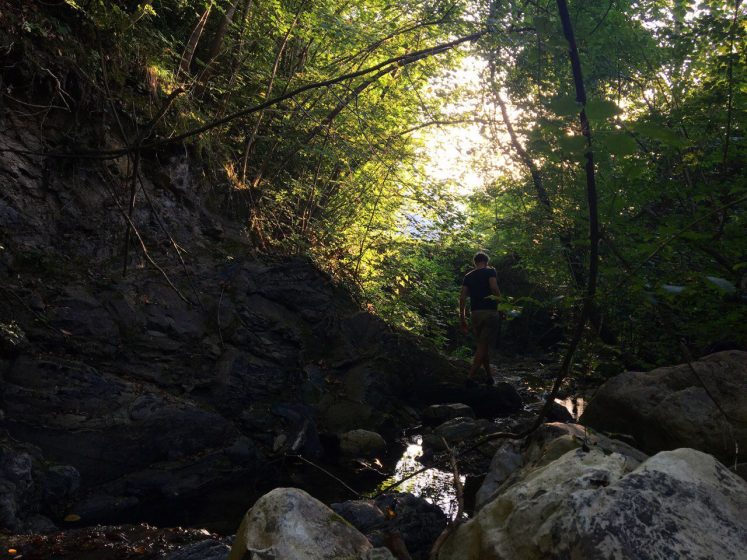
Alder
There is a tiny hollow on the western slope of the Italian Appenine mountains I often return to. It is just a small depression in the hills between steep walls formed from boulders, moss and stones. On its floor a silent creek runs over pebbles and rocks. Every twenty feet or so there is a gentle cascade, a big block stopping the straight flow of the brook, broadening it into a little pond. On its bottom the water is clear, freckled by the sun which shines through the leaves overhead and throws bright spots on the sandy ground. It lightens up the occasional tadpole and glistens in the quick movements of water skeeters. These insects glide over the current, unmoved by the water’s force and by my playful attempts to catch them.
The boulders at the sides of the brook are held in place by alder trees. The alder fruits from last year lie at the bottom of the water—little dark cylinders with deep, regular clefts. The skeeters cast fleeting shadows over them, when they pass without noise overhead. The little hollow is silent, sheltered against the rumour of the outside world, remote even from the benign chatter of the Italian summer.
I hear the low gurgle of the water on the stones and the slight rustling of the alder leaves. They expand their waxy surfaces above the creek and protect it from the sun. The leaves grow from slender stems, flecked by spots of white and grey lichens, a sign of the clean air in these hills, of time causing no pain.
Whenever I can, I return to this quiet place, this magical well of silence springing forth among the boulders and the alders. There is an old folktale it reminds me of, a tale about a spring in the woods with alders around it. I remember that the hero of this tale listened to their whisper and learned something important.
I feel called by this little hollow, sheltered by the alders. Their leaves mutter something to me my mind does not decipher, but my body still understands, by the same magic as the hero in the folk tale understands the nonhuman creatures. I feel drawn to this place, and I have started to think that this pull is its love for me. I am welcomed by it. It is calling me.
Deep down I know that my need to return to this place is my own way of understanding the trees. It is my manner of heeding their call to be a conscious part of the huge exchange of bodies and breath which creates what our scientifically informed minds have come to call the “biosphere”.
The alders’ call pulls me with a force which we have learned to view as the experience of “beauty”. But beauty is not a viewpoint, it is a power. I do not look at the alders, they look at me. I do not listen to them, but am addressed by their whisper. The encounter with an “aesthetic object” (or the “creation of it” through our culturally informed, language-based mind)—in truth is the experience to be welcomed into the family of life.
I have no real language for this, and indeed not even an experiential concept. Our culture doesn’t. I only know that the alders draw me towards them, and that the world feels right in their dim light, under the speckles their whispering leaves cast on the movements of the clear, nourishing water. The alders whisper to me, as they whispered in the folktale with the magical spring.
Their message now is as simple as it was in the tale. It says: “You have the power. You have the life. Don’t be afraid. Don’t be stingy. You don’t need to. You are provided all you need. You’re welcomed. You are here. You are.”
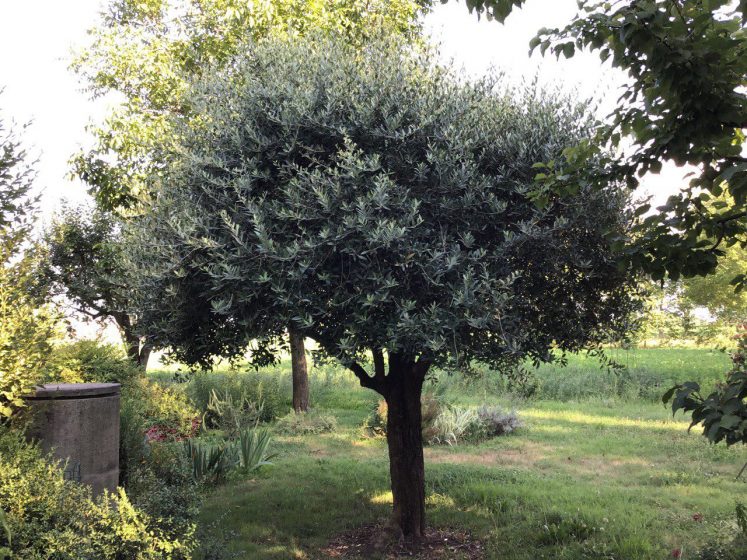
Olive
When I went to Italy this year to spend my summer in the coastal Appenine mountains, my mother-in-law refused to meet us at close distance. She was still shocked by the tens of thousands of deaths in the Lombardy region where she and her husband live. When we arrived at her place, halfway to the mountains, she had prepared the flat in the other house for us. It was the place her father had built in the 1960s and where he had lived all his life. Now we used it when we paused on our way into the mountains with their wild streams and growling pebbles and stranded logs. Normally there was a big family dinner every time we arrived. This time it was only us, me and my wife, in the other house.
My mother-in-law’s father had worked the garden and provided the family with food all his life: tomatoes, peppers, courgettes, aubergines, beans, potatoes, onions, carrots. There was a sense of bounty in the house which did not go away with his death. After we had arrived this evening we sat alone in the grandpa’s kitchen. The table was set with wine and fruit, with parmesan and salami, fish and cake. And the refrigerator held more. When we had just started eating, the old interphone to the inlaws’ adjacent house rang. “Is there really enough food for you?” my mother-in-law anxiously asked.
When her father had died, she planted an olive tree. She did not grow vegetables anymore. So, the garden was empty until they sat the olive tree in its middle. I went to see it the next morning, in the rose-coloured early light, in the soft air of the summer of the Italian plain. The first cicadas had already started to shrill. The pale underside of the olive leaves glittered slowly in a faint breeze. I touched them. Their surface, leathery, elastic, strong, seemed to me like muscular tissue, well trained to relentlessly work in the heat, ready to harvest sunlight, to make a generous home from the gift of the sun.
Touching the leaves, I felt a sort of consolation, the promise of always being part of a generous family. The bark on the stem, still youthfully smooth, started to become coarse, and mature, and timeless. I looked south and could see the Appenines as a blue veil over the horizon, behind the straight rows of poplars, softly swaying on the neighbour’s land. The olive tree just stood there, its muscular leaves harvesting light, its swelling fruits concentrating the sun into golden liquid, the stem promising that rather time would stand still than generosity end.
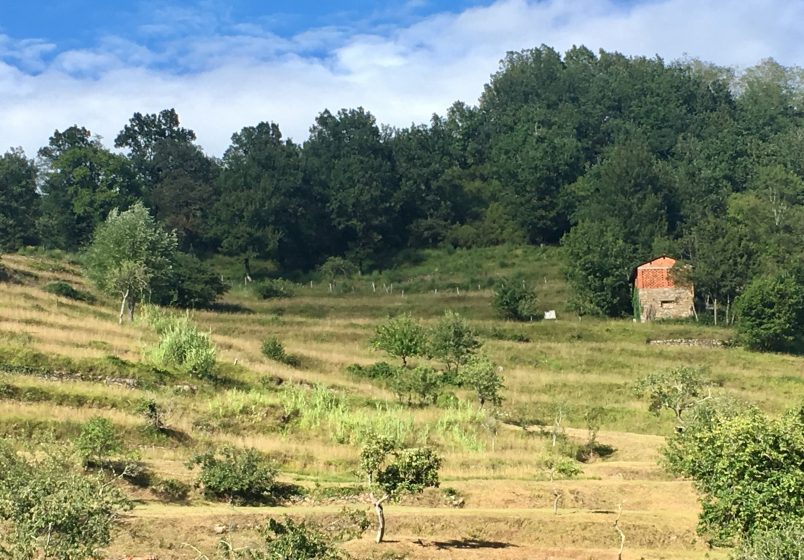
Almond
The sun is setting above the western slope of the hill. Its last rays infuse the landscape with warmth, add orange and gold to the predominantly yellow and red colors of the dry August evening. The long grass is mostly thin and yellow. The tired blades are interspersed with white umbrellas, the blossoms of wild carrots on slender stalks. No peasant has made hay here for the last decade.
The hill is becoming a prairie again. In another ten years, it will be a young forest. The thick yellow grass covers the edges of the old terraces and blurs their contours. This slope has been shaped by generations of peasants. They have leveled the terrain, sorted out the stones and heaped them up in order to strengthen the walls that hold the terraces.
The peasants also planted the fruit trees. A handful of them stand still in the midday heat. They are not much taller than ten feet, skinny and old, thirsty, with many yellow leaves among the green ones. Dead twigs form nest-like bundles in the canopy. I count two plum-trees, three apricots, and an almond tree. On each of them, only a few fruits are dangling in the heat, echoing the sun’s late fire with yellow, orange and red hues.
The almond carries but one fruit. The green layer around it has already dried and given way to the hard shell with its lines and crevasses. When I touch the almond fruit slightly, it falls into my hand. I weigh it on my palm, put my nose to it and sniff. The fruit smells slightly bitter and sweet, although the edible kernel is still protected by the tight case.
I watch the pattern on the shell. I sink my gaze into it, into the little oval-shaped cosmos with the seed of life inside, a little universe in itself. I watch the lines on the shell-like frozen trajectories of long lost stars. I think: The lines in the almond shell are traces the developing fruit has left in matter. The lights of the celestial bodies are traces the developing universe has carved into space.
I think: We can witness the Big Bang everywhere. Indeed, we can understand that everything we encounter actually is the Big Bang, which is still diversifying into innumerable lifelines and encounters. It explodes through the fine traces which the long grass blades at the foot of the Almond tree leave on the bare skin of my legs as I pass. It unfolds with the flickering routes of the fireflies when the evening settles over barren trees on the terraces of these hills. It expands with raindrops rolling through the dust, leaving fragile trails. It unfolds in the minute tubing within the almond leaves, desperately sucking up water from the dry ground. It is there in the microscopic tunnels the root hairs are digging through the gravelly soil in search for liquid.
I think: The world is born in every moment. What we perceive of it are the traces of this birth, traces of force meeting force and igniting stars on its way, of desire meeting desire and letting flesh growing forth. We look at a cracked rock in the riverbed, the black lines on its neat halves flying through the white flesh of its inside, and we realize that the birth inside of it has been happening for billions of years. We inhale the air around us and within an eyelid’s flutter are we amidst the Big Bang. We are birthing being all the time. This is what is going on here, this is what we are about.
The almond looked at me, an eye full of knowledge that I had always known. The setting sun above the horizon was about to melt into the hilltop. From this act of fusion it would bring back a fresh new day.
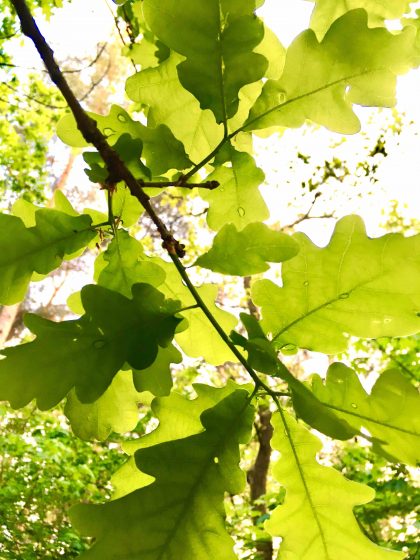
Oak
It was a bright and dry early autumn evening, and I decided that I would set out into the forest and offer the little oak some water. It had been a long and exceedingly dry summer, and the forest floor was burned yellow. All flowers and most of the undergrowth had withered away, leaving only discolored straw under the pines, oaks, lindens, and maples. Also, some of the younger trees had given up the struggle. They had turned pale overnight, like somebody suddenly loosening the grip of his hand keeping him above an abyss.
The little oak had survived because I had constantly watered it. I had visited it nearly every evening. I had come to celebrate these short journeys into the forests as meditative time-outs, as attempts to become somebody who was not only taking from the forest (the experience of beauty, the experience of being welcomed), but who tried to give something back.
I had dug a little pit around the thumb-thick stem of the oak where I poured the water I brought in bottles and canisters. Sometimes I carried more than ten gallons into the forest and spend an hour in the company of the tree baby, waiting until the water had sunk into the dry and dusty ground sparsely covered with faded St. John’s Wort, and then pouring more, pouring life into the oak.
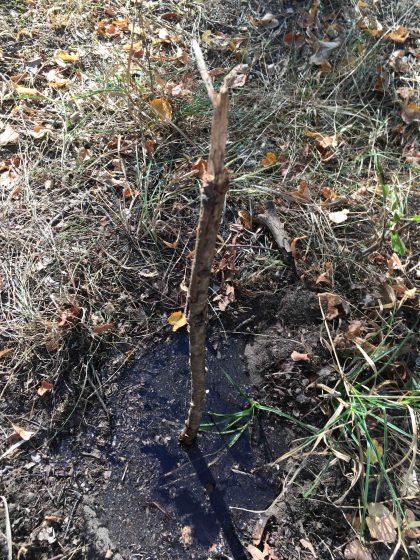
This afternoon, when I arrived on the clearing where we had planted the sapling, at first I could not find it. My wife had given it to me for my birthday shortly after we met, and it had sat a while on her balcony, until we planted it into the forest one rainy day in March, illegally adding our little oak to the other oak trees, carrying owls to Athens. It had grown astonishingly for two years. I remember the happy disbelief when the little oak pushed out its first leaves that spring two years ago.
The year after planting our tree baby into the forest soil, in the high summer of last year, we had celebrated our wedding on the clearing, with a few chosen friends, and bound ourselves to one another, and to the earth. I had thrown a water canister on the trolley a friend pulled through the forest to the ceremony site, heaped with crushed ice and champagne. We had closed the ritual by watering the little oak.
Now it seemed to be gone. Nothing of its about five foot-high foliage, grey-green and leathery, was to be seen. I slowly realized that it had been broken at the stem, ten inches above the soil. Only a stub, obliquely fractured, rose forth from the earth, helplessly pointing to the sky. I blinked and hoped the image would fade and the living tree would appear again. I sat down with a weak feeling. Then I began to pour my gallon of water around the stub. I had no idea who had broken it, or what, and why.
Oaks are very tough trees which can thrive with little water, weather storms, survive lighting and moulds, and grow really old. But they are not good at pushing out a mass of new green after being cut. They are not as regenerative as linden trees, or olives, or alders, or aspens. They break, and then aristocratically die.
The little oak did not stir for the rest of the year. Then autumn came, and rain, and winter, and more rains, and cold temperatures. The oak did not move. On a wet day in March, just before lockdown struck, I noticed that the colour of the stem had changed. It had taken on a distinctively green hue, as if under the thin bark the tree prepared to act.
Goethe was the first to observe, in his “Metamorphosis of the Plant”, that all plant parts are functionally equal, that the blossom is a transformation of the stem, or rather of the stems potential to split and morph into leaves. So it seemed to be here. A tree, a young one at least, was able to behave as one giant leaf. I left the clearing in the wet and barren forest with my heart pounding.
And then corona came, and we all stayed indoors as much as we could, and I didn’t travel to our secret forest spot for weeks. I only went back in May. Two transparent leaves had unfolded, like light green bat wings, from a spot that had broken open in the stem. I realized that more of these spots had started to swell. The bark, which protected the tree as a wall and closed it onto itself, had started to do the opposite. It became a door, through which life could unfold into the world.
I kneeled there in the moisture of life giving birth to more life, still a bit insecure of my newly won freedom to roam after lockdown had been lifted. I thought of a phrase a friend had told me many years ago. “The soul is a plant”, it went. Yes, I thought, and maybe the plant is a soul, too.
Andreas Weber
Berlin

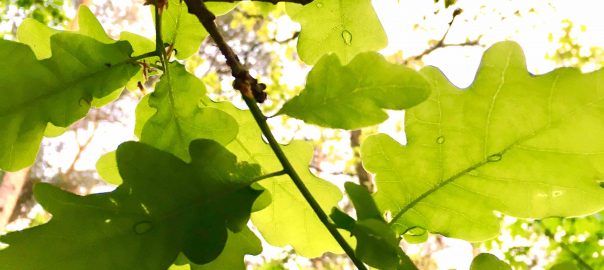






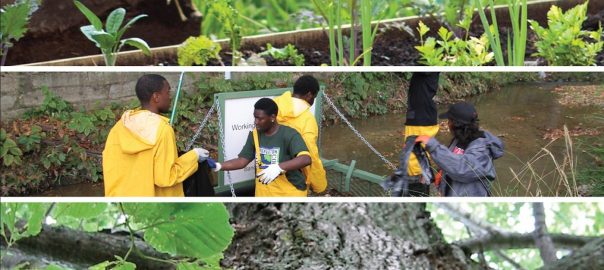
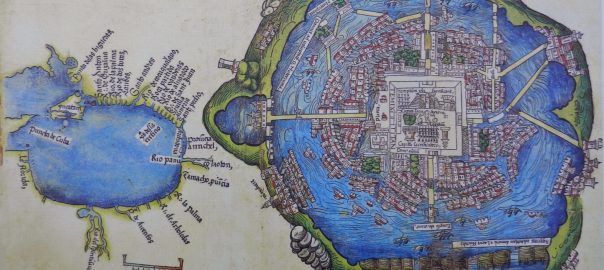
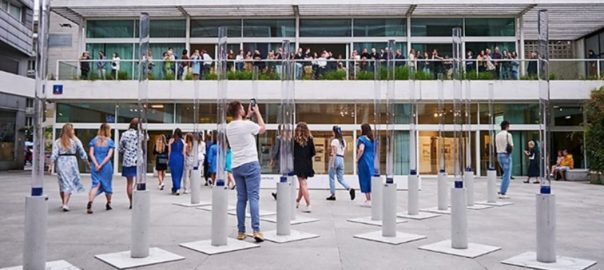
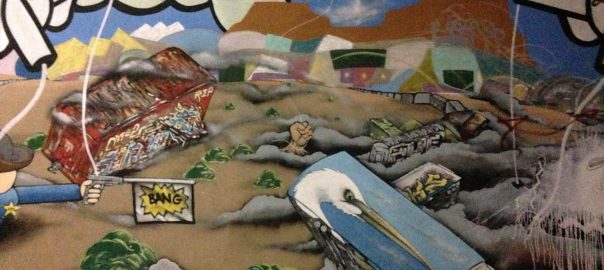
May the little oak continue to regenerate itself. Perhaps the love and care you gave it enabled hope and life to rise from the damage it endured.
Sometimes a plant that has endured unbearable deprivation will still survive. I have one in my garden. A callistemon that a neighbour forgot to water while I was away for a month.
The little callistemon seemed doomed, but my daughter cut it back and showed me the green in the twigs. Now it stands sturdy and proud with beautiful pink blossoms in season that the honey eaters adore.
Beautiful to feel your words alive and fruitful within me.
Our challenge to help the thick bark of modern society give way to the soft sprouts of sensitivities within us all;
enliven our memories of a shared diversity; a cosmic destiny.
Thanks so much
Love
Pete